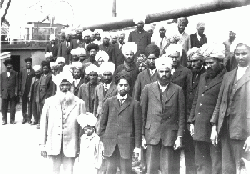Template:AOW192: Difference between revisions
Hari singh (talk | contribs) No edit summary |
Hari singh (talk | contribs) No edit summary |
||
| (4 intermediate revisions by the same user not shown) | |||
| Line 2: | Line 2: | ||
[[Image:Gurditsinghduringleft.gif|thumb|250px|Indian immigrants aboard the ''"Komagata Maru"'']] | [[Image:Gurditsinghduringleft.gif|thumb|250px|Indian immigrants aboard the ''"Komagata Maru"'']] | ||
'''The Komagata Maru''' was a Japanese steam liner, that was chartered by an affluent businessman, [[Gurdit Singh]], to bring [[Indian]] immigrants to [[Canada]] | '''[[The Komagata Maru]]''' was a Japanese steam liner, that was chartered by an affluent businessman, [[Gurdit Singh]], to bring [[Indian]] immigrants to [[Canada]] in [[1914]]. | ||
It began its journey from Hong Kong, sailed to Shanghai, China, then to Yokohama, Japan, and then on to [[Vancouver]], British Columbia [[Canada]] where it arrived in Burrard Inlet, near [[Vancouver]], on '''May 23'''. This journey took place in [[1914]], carrying 376 passengers from [[Punjab]], [[India]]. | |||
The majority of these Indians were [[Punjabi]]s who had settled in [[Canada]] in the hope of finding work so that they could improve their economic situation from what it had been in the [[Punjab]]. On arrival in Canada they encountered discrimination and were not welcomed by the white Canadians people who wanted the "brown invasion" to stop. The Canadian majority felt that the [[Indian]]s would take over their jobs. It was these insecurities which led British Columbia to pass stringent laws discouraging the immigration of | During the period before 1920's the whole of North America has a policy of discrimination against coloured races which was thinly disguised to appear as something else. The dominate white governments of [[USA]] and [[Canada]] were determined not to allow the flow of Asians, whether so called 'yellow', 'brown' or 'black' immigrants. In the year 1900 the census reported 2050 people from [[India]] on the North American continent. | ||
The majority of these Indians were [[Punjabi]]s who had settled in [[Canada]] in the hope of finding work so that they could improve their economic situation from what it had been in the [[Punjab]]. <!---On arrival in Canada they encountered discrimination and were not welcomed by the white Canadians people who wanted the "brown invasion" to stop. The Canadian majority felt that the [[Indian]]s would take over their jobs. It was these insecurities which led British Columbia to pass stringent laws discouraging the immigration of [[Indian]]s to [[Canada]]. ---->{{aowf|Komagata Maru}} | |||
Latest revision as of 18:37, 24 May 2012
The Komagata Maru was a Japanese steam liner, that was chartered by an affluent businessman, Gurdit Singh, to bring Indian immigrants to Canada in 1914.
It began its journey from Hong Kong, sailed to Shanghai, China, then to Yokohama, Japan, and then on to Vancouver, British Columbia Canada where it arrived in Burrard Inlet, near Vancouver, on May 23. This journey took place in 1914, carrying 376 passengers from Punjab, India.
During the period before 1920's the whole of North America has a policy of discrimination against coloured races which was thinly disguised to appear as something else. The dominate white governments of USA and Canada were determined not to allow the flow of Asians, whether so called 'yellow', 'brown' or 'black' immigrants. In the year 1900 the census reported 2050 people from India on the North American continent.
The majority of these Indians were Punjabis who had settled in Canada in the hope of finding work so that they could improve their economic situation from what it had been in the Punjab. .....More

